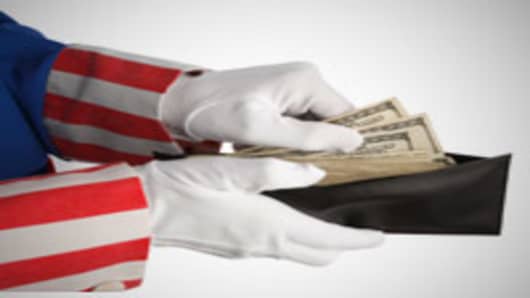Now it can be told: The bank that exposed the federal government to the greatest potential loss during the government bailout was Citigroup, which received a grand total of $476.2 billion in cash and guarantees, according to a new report of the Congressional Oversight Panel which oversees the TARP program.
The Oversight panel tallied up the amounts of aid each bank received from the alphabet-soup panoply of federal bailout efforts, including TARP, the FDIC and the Federal Reserve.
For example, of Citi's total federal assistance, $25 billion came from the TARP's CPP program, $68.6 billion came from the FDIC's TLGP debt issuance program, and $88 billion came from the Federal Reserve's TAF liquidity program, among others.
The second biggest recipient of federal assistance, the new report says, was Bank of America , which racked up $336.1 billion in federal help.
Third on the list was Morgan Stanley , with a total of $135 billion in help.
The Congressional Oversight Panel, which was created by Congress to watch over TARP money, is winding down this week—but not before putting out its final report on the bailout era in American finance .
The problem with TARP, the panel said, was that it created a moral hazard: "Very large financial institutions may now rationally decide to take inflated risks because they expect that, if their gamble fails, taxpayers will bear the loss," the report concluded. "Ironically, these inflated risks may create even greater systemic risk and increase the likelihood of future crises and bailouts. In addition, Treasury‘s intervention in the automotive industry, rescuing companies that were not banks and were not particularly interconnected within the financial system, extended the?too big to fail guarantee and its associated moral hazard to non-financial firms."
And the panel also accused Treasury of not asking for enough data on exactly where all that bailout cash actually went. "Treasury decided in the TARP‘s earliest days to push tens of billions of dollars out the door to very large financial institutions without requiring banks to reveal how the money was used," the panel noted. "As a result, the public will never know to what purpose its money was put."
All in all, however, the oversight panel was relatively complimentary toward government officials' efforts to stabilize the global financial system: "It is now clear that, although America has endured a wrenching recession, it has not experienced a second Great Depression. The TARP does not deserve full credit for this outcome, but it provided critical support to markets at a moment of profound uncertainty. It achieved this effect in part by providing capital to banks but, more significantly, by demonstrating that the United States would take any action necessary to prevent the collapse of its financial system."
Treasury officials convened a conference call with reporters Tuesday evening to mount a strong defense of the TARP program. "Where we are today shows that the program, by any reasonably objective measure, was a success," said Acting Assistant Secretary Timothy Massad. "It was vital that the government act with overwhelming force...we broke the back of the crisis."
And Massad disputed that the too-big-to-fail problem remains an issue, citing new powers given to government regulators under the Dodd Frank act to wind down systemically risky financial firms.



